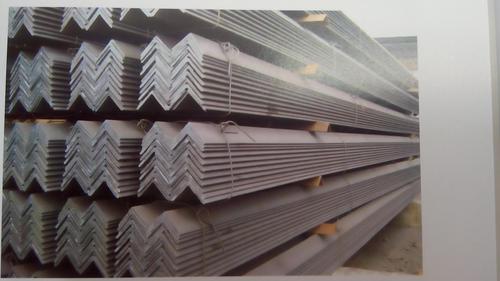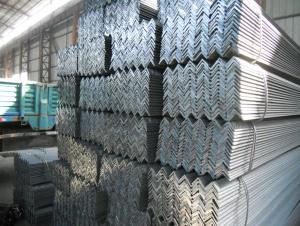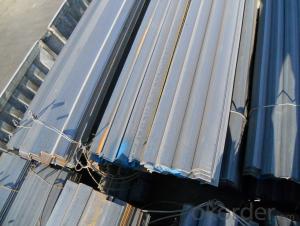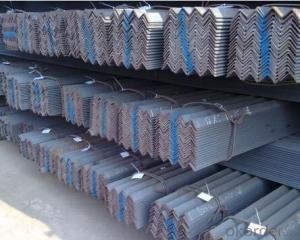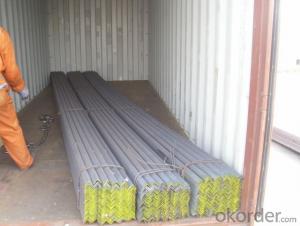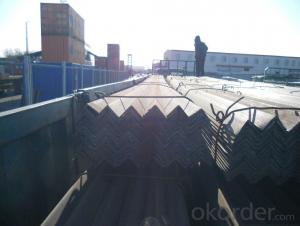Angle Bar Steel 6M or 12M EN10025,JIS G3192,DIN 1026,GB 707-88
OKorder Service Pledge
OKorder Financial Service
You Might Also Like
Product Description:
OKorder is offering Angle Bar Steel 6M or 12M EN10025,JIS G3192,DIN 1026,GB 707-88 at great prices with worldwide shipping. Our supplier is a world-class manufacturer of steel, with our products utilized the world over. OKorder annually supplies products to European, North American and Asian markets. We provide quotations within 24 hours of receiving an inquiry and guarantee competitive prices.
Product Applications:
Angle Bar Steel 6M or 12M EN10025,JIS G3192,DIN 1026,GB 707-88 are ideal for structural applications and are widely used in the construction of buildings and bridges, and the manufacturing, petrochemical, and transportation industries.
Product Advantages:
OKorder's Angle Bar Steel 6M or 12M EN10025,JIS G3192,DIN 1026,GB 707-88 are durable, strong, and resist corrosion.
Main Product Features:
· Premium quality
· Prompt delivery & seaworthy packing (30 days after receiving deposit)
· Corrosion resistance
· Can be recycled and reused
· Mill test certification
· Professional Service
· Competitive pricing
Product Description:
Specifications of Angle Steel
1. Invoicing on theoretical weight or actual weight as customer request
2. Length: 6m, 9m, 12m as following table
3. Sizes
Sizes: 25mm-250mm | ||
a*t | ||
25*2.5-4.0 | 70*6.0-9.0 | 130*9.0-15 |
30*2.5-6.6 | 75*6.0-9.0 | 140*10-14 |
36*3.0-5.0 | 80*5.0-10 | 150*10-20 |
38*2.3-6.0 | 90*7.0-10 | 160*10-16 |
40*3.0-5.0 | 100*6.0-12 | 175*12-15 |
45*4.0-6.0 | 110*8.0-10 | 180*12-18 |
50*4.0-6.0 | 120*6.0-15 | 200*14-25 |
60*4.0-8.0 | 125*8.0-14 | 250*25 |
5. Payment terms:
1).100% irrevocable L/C at sight.
2).30% T/T prepaid and the balance against the copy of B/L.
3).30% T/T prepaid and the balance against L/C
6.Material details:
Alloy No | Grade | Element (%) | |||||
C | Mn | S | P | Si | |||
|
|
|
|
|
|
| |
Q235 | B | 0.12—0.20 | 0.3—0.7 | ≤0.045 | ≤0.045 | ≤0.3 | |
|
|
|
|
|
|
| |
Alloy No | Grade | Yielding strength point( Mpa) | |||||
Thickness (mm) | |||||||
≤16 | >16--40 | >40--60 | >60--100 | ||||
≥ | |||||||
|
|
|
|
|
| ||
Q235 | B | 235 | 225 | 215 | 205 | ||
Alloy No | Grade | Tensile strength (Mpa) | Elongation after fracture (%) | ||||
Thickness (mm) | |||||||
| ≤16 | >16--40 | >40--60 | >60--100 | |||
≥ | |||||||
|
|
|
|
|
|
| |
Q235 | B | 375--500 | 26 | 25 | 24 | 23 | |
Usage & Applications of Angle Steel
According to the needs of different structures, Angle can compose to different force support component, and also can be the connections between components. It is widely used in various building structures and engineering structures such as roof beams, bridges, transmission towers, hoisting machinery and transport machinery, ships, industrial furnaces, reaction tower, container frame and warehouse etc.
Packaging & Delivery of Angle Steel
1. Packing: it is nude packed in bundles by steel wire rod
2. Bundle weight: not more than 3.5MT for bulk vessel; less than 3 MT for container load
3. Marks:
Color marking: There will be color marking on both end of the bundle for the cargo delivered by bulk vessel. That makes it easily to distinguish at the destination port.
Tag mark: there will be tag mark tied up on the bundles. The information usually including supplier logo and name, product name, made in China, shipping marks and other information request by the customer.
If loading by container the marking is not needed, but we will prepare it as customer request.
Production flow of Angle Steel
Material prepare (billet) —heat up—rough rolling—precision rolling—cooling—packing—storage and transportation
FAQ:
Q1: Why buy Materials & Equipment from OKorder.com?
A1: All products offered byOKorder.com are carefully selected from China's most reliable manufacturing enterprises. Through its ISO certifications, OKorder.com adheres to the highest standards and a commitment to supply chain safety and customer satisfaction.
Q2: How do we guarantee the quality of our products?
A2: We have established an advanced quality management system which conducts strict quality tests at every step, from raw materials to the final product. At the same time, we provide extensive follow-up service assurances as required.
Q3: How soon can we receive the product after purchase?
A3: Within three days of placing an order, we will begin production. The specific shipping date is dependent upon international and government factors, but is typically 7 to 10 workdays.
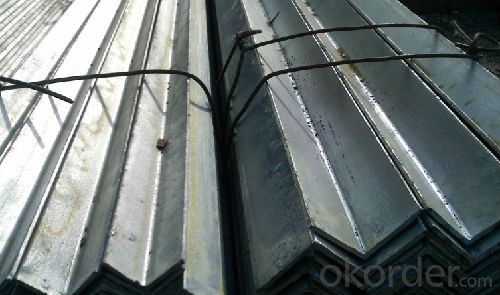
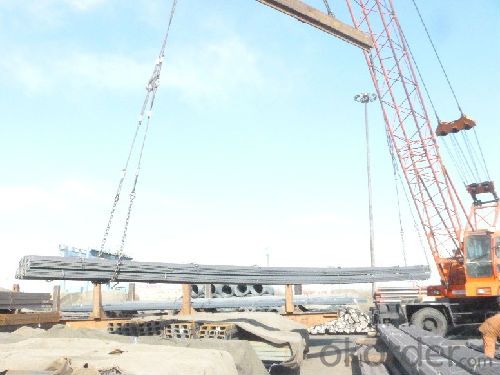
- Q: What is the maximum axial load for a steel angle?
- The maximum axial load for a steel angle depends on several factors including the dimensions and thickness of the angle, the grade and quality of the steel, and the specific application or use of the angle. However, in general, the maximum axial load for a steel angle can be determined by calculating its allowable stress or ultimate strength. The allowable stress is the maximum stress that a material can withstand without experiencing permanent deformation or failure. To calculate the allowable stress for a steel angle, you would need to know the yield strength of the steel. This is the stress at which the material begins to permanently deform or yield. The maximum axial load can then be calculated by multiplying the allowable stress by the cross-sectional area of the angle. On the other hand, the ultimate strength is the maximum stress that a material can withstand before it fractures or breaks. If the ultimate strength of the steel is known, the maximum axial load can be calculated by multiplying the ultimate strength by the cross-sectional area of the angle. It is important to note that the maximum axial load also depends on the length and support conditions of the steel angle. Longer angles or angles with inadequate support may experience additional bending or buckling, which can affect their maximum load-bearing capacity. In summary, the maximum axial load for a steel angle can be determined by calculating its allowable stress or ultimate strength, considering the dimensions, thickness, grade, and quality of the steel, as well as the specific application and support conditions. It is recommended to consult engineering handbooks or reference materials specific to the type of steel angle being used for accurate load capacity calculations.
- Q: Are steel angles suitable for supporting rooftop equipment?
- Yes, steel angles are suitable for supporting rooftop equipment. Steel angles offer sturdy support and can withstand the weight and stress of rooftop equipment, making them a reliable choice for this purpose.
- Q: What is the cost of a steel angle?
- The cost of a steel angle can vary depending on several factors such as the size, grade, thickness, and the supplier or manufacturer. Generally, steel angles are priced per length or per weight. It is important to consider the market conditions, location, and the specific requirements of the steel angle needed when determining the cost. It is recommended to contact local suppliers or manufacturers for accurate and up-to-date pricing information.
- Q: Can steel angles be used for foundation supports?
- Yes, steel angles can be used for foundation supports. Steel angles provide structural support and stability, making them suitable for various construction applications, including foundation supports.
- Q: Can steel angles be used for framing or supporting suspended ceilings?
- Steel angles, known for their strength and durability, are frequently employed in construction to offer structural support and stability. They are ideal for framing and supporting suspended ceilings. By affixing steel angles to walls or ceilings, a framework for the suspended ceiling system can be established. Complementing materials like hangers, wires, and channels are often used in conjunction with steel angles to ensure a secure and stable structure for the suspended ceiling. Furthermore, steel angles can be customized and cut to precise lengths and sizes, enabling their versatility in a wide range of framing and supporting applications.
- Q: How do steel angles contribute to the overall aesthetics of a structure?
- There are multiple ways in which steel angles can enhance the overall aesthetics of a structure. To start with, they can serve as decorative elements that generate captivating and visually pleasing designs. By integrating steel angles into the architectural design, unique and distinctive features can be added to the structure. For instance, patterns, shapes, or even sculptures can be fashioned from steel angles, thereby enhancing the building's aesthetic appeal. Moreover, steel angles can establish a sense of balance and symmetry within the structure. Architects can strategically position steel angles at specific locations to create visually pleasing and harmonious designs. These angles can effectively break up large, monotonous surfaces, introducing depth and dimension to the structure and making it more visually captivating. Additionally, steel angles contribute to the aesthetic appeal of a structure by providing a sleek and modern appearance. The clean lines and sharp edges of steel angles lend a contemporary and industrial look to the building, which is often sought after in modern architecture. Furthermore, the use of steel angles can convey a sense of strength and stability, visually appealing and reassuring to observers. Lastly, steel angles can be employed to enhance the overall structural integrity of the building. While aesthetics are important, ensuring the safety and stability of the structure is crucial. By strategically placing steel angles, additional support and reinforcement can be provided, guaranteeing that the building is not only visually appealing but also structurally sound. In conclusion, steel angles contribute to the overall aesthetics of a structure by adding decorative elements, creating balance and symmetry, providing a sleek and modern appearance, and enhancing the structural integrity. By incorporating steel angles into the design, architects can create visually stunning buildings that are both aesthetically pleasing and structurally sound.
- Q: How do you determine the load-bearing capacity of a steel angle?
- In order to ascertain the load-bearing capacity of a steel angle, several considerations must be made. Initially, the material properties of the steel angle need to be known, including its yield strength and ultimate tensile strength. These values can be acquired from the manufacturer or relevant material standards. Subsequently, the dimensions and shape of the steel angle play a crucial role in determining its load-bearing capacity. Precise measurements of the angle's thickness, width, and length are necessary. Additionally, the angle's shape, whether it is equal or unequal, must also be taken into account. Once these properties are established, the load-bearing capacity can be calculated utilizing engineering principles and structural analysis methods. One common approach involves the use of Euler's formula, which considers the bending and axial loads on the steel angle. Euler's formula states that the load-bearing capacity of a steel angle is proportionate to its moment of inertia and the modulus of elasticity. These values are calculated based on the angle's dimensions and shape. Moreover, other factors such as the angle's end supports, the type of loading (e.g., concentrated load or uniformly distributed load), and any additional safety factors must be considered. It is important to note that determining the load-bearing capacity of a steel angle is a complex process that requires expertise in structural engineering. Therefore, it is advisable to seek consultation from a qualified engineer or refer to relevant design codes and standards to ensure accurate and safe calculations.
- Q: How do you calculate the compression strength of a steel angle?
- To calculate the compression strength of a steel angle, you need to consider the cross-sectional area of the angle and the yield strength of the steel. The compression strength can be calculated by multiplying the cross-sectional area of the angle by the yield strength of the steel.
- Q: Can steel angles be used for staircases?
- Yes, steel angles can be used for staircases. Steel angles are commonly used in construction for their strength and durability. When it comes to staircases, steel angles are often used as stringers or support beams to provide structural stability. They can be used to create the framework or skeleton of the staircase, supporting the steps and providing a sturdy structure for people to walk on. Steel angles are versatile and can be easily customized and fabricated to meet specific design requirements for staircases. Additionally, steel angles are resistant to corrosion, making them suitable for both indoor and outdoor staircases.
- Q: What are the different types of steel angles used in automotive engineering?
- In automotive engineering, there are several types of steel angles that are commonly used. These angles play a crucial role in providing structural strength, improving stability, and enhancing the overall performance and safety of vehicles. Here are some of the different types of steel angles used in automotive engineering: 1. L-angles: L-angles, also known as unequal angles, are often used in automotive engineering to provide structural support and reinforcement. These angles have different lengths on each side, allowing them to be easily welded or bolted onto various components of a vehicle's chassis or frame. 2. T-angles: T-angles, also known as tee angles, are frequently used in automotive engineering to join two components together at a right angle. These angles are designed with a flat base and a vertical stem, which enables them to provide stability and hold different parts of a vehicle securely in place. 3. C-angles: C-angles, also known as channel angles, are commonly utilized in automotive engineering to form the framework for various vehicle structures. These angles have a U-shaped cross-section and are often used to create structural components like door frames, roof rails, and chassis reinforcements. 4. Z-angles: Z-angles, also known as Z-bar angles, are widely employed in automotive engineering to provide strength and rigidity to different vehicle structures. These angles have a Z-shaped cross-section, which allows them to resist bending and torsional forces effectively. Z-angles are often used in applications such as suspension systems, roll bars, and body components. 5. U-angles: U-angles, also known as U-bar angles, are commonly used in automotive engineering to provide support and reinforcement to various vehicle components. These angles have a U-shaped cross-section and are frequently utilized to create structural members like bumper beams, frame reinforcements, and roll cage bars. These are just a few examples of the different types of steel angles used in automotive engineering. Each angle has its own unique properties and applications, and their selection depends on the specific requirements of the vehicle design and the desired structural integrity.
Send your message to us
Angle Bar Steel 6M or 12M EN10025,JIS G3192,DIN 1026,GB 707-88
OKorder Service Pledge
OKorder Financial Service
Similar products
Hot products
Hot Searches
Related keywords






